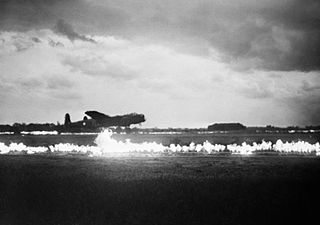 W
WA dogfight, or dog fight, is an aerial battle between fighter aircraft conducted at close range. Dogfighting first occurred in Mexico in 1913, shortly after the invention of the airplane. Until at least 1992, it was a component in every major war, despite beliefs after World War II that increasingly greater speeds and longer-range weapons would make dogfighting obsolete.
 W
WDogfights is a military aviation themed TV series depicting historical re-enactments of air-to-air combat that took place in World War I, World War II, the Korean War, and the Vietnam War, as well as smaller conflicts such as the Gulf War and the Six-Day War. The program consists of former fighter pilots sharing their stories of actual dogfights in which they took part, combined with computer-generated imagery (CGI) to give the viewer a better perspective of what it is like to engage in aerial combat. Dogfights originally aired on the History Channel from November 2006 to May 2008. Repeats of the series are currently airing on the digital broadcast network Quest.
 W
WFog Investigation and Dispersal Operation (FIDO) was a system used for dispersing fog and pea soup fog from an airfield so that aircraft could land safely. The device was developed by Arthur Hartley for British RAF bomber stations, allowing the landing of aircraft returning from raids over Germany in poor visibility by burning fuel in rows on either side of the runway.
 W
WA Judas goat is a trained goat used in general animal herding. The Judas goat is trained to associate with sheep or cattle, leading them to a specific destination. In stockyards, a Judas goat will lead sheep to slaughter, while their own life is spared. Judas goats are also used to lead other animals to specific pens and onto trucks. They have fallen out of use in recent times, but can still be found in various smaller slaughterhouses in some parts of the world, as well as conservation projects.
 W
WL'Aviation Militaire was a book written by the French inventor Clément Ader and published in 1909 by the Paris publisher Berger-Levrault. The book was essentially based on ideas developed by Ader at the end of the 19th century, which were arranged in final form in 1907. It was hugely popular, and went through 10 editions in the five years between its publication and the First World War.
 W
WA loitering munition is a weapon system category in which the munition loiters around the target area for some time, searches for targets, and attacks once a target is located. Loitering munitions enable faster reaction times against concealed or hidden targets that emerge for short periods without placing high-value platforms close to the target area, and also allow more selective targeting as the actual attack mission can be aborted.
 W
WAerial reconnaissance is reconnaissance for a military or strategic purpose that is conducted using reconnaissance aircraft. The role of reconnaissance can fulfil a variety of requirements including artillery spotting, the collection of imagery intelligence, and the observation of enemy maneuvers.
 W
WThe Saudi Arabian Air Defense Forces or officially Royal Saudi Air Defense Forces (RSADF) is the aerial defense service branch of the Saudi Arabian Armed Forces. It is fourth of the five service branches of the MOD. It has its HQ in Riyadh, where there is also an elaborate underground command facility that co-ordinates Arabian Kingdom's advanced "Peace Shield" radar and air defense system, with an estimated 40,000 active duty military personnel in 2015. Along with the Royal Saudi Air Force (RSAF), it has responsibility for securing the skies of Saudi Arabia.
 W
WIn military aviation, scrambling is the act of quickly mobilising military aircraft. Scrambling can be in reaction to an immediate threat, usually to intercept hostile aircraft.
 W
WA squadron in air force, army aviation, or naval aviation is a unit comprising a number of military aircraft and their aircrews, usually of the same type, typically with 12 to 24 aircraft, sometimes divided into three or four flights, depending on aircraft type and air force. Land based squadrons equipped with heavier type aircraft such as long-range bombers, cargo aircraft, or air refueling tankers have around 12 aircraft as a typical authorization, while most land-based fighter equipped units have an authorized number of 18 to 24 aircraft.
 W
WStealth technology, also termed low observable technology, is a sub-discipline of military tactics and passive and active electronic countermeasures, which covers a range of methods used to make personnel, aircraft, ships, submarines, missiles, satellites, and ground vehicles less visible to radar, infrared, sonar and other detection methods. It corresponds to military camouflage for these parts of the electromagnetic spectrum.
 W
WA tail gunner or rear gunner is a crewman on a military aircraft who functions as a gunner defending against enemy fighter attacks from the rear, or "tail", of the plane.
 W
WThud Ridge is a 1969 memoir by Jack Broughton about flying the F-105 "Thud" for the United States Air Force in the Vietnam War during Operation Rolling Thunder. The title Thud Ridge derives from the nickname given by F-105 pilots to the Tam Dao range, which was both a waypoint during air attacks in the vicinity of Hanoi, North Vietnam, and a terrain masking feature for ingressing fighters.